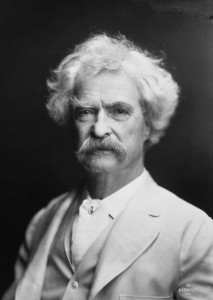Samuel Langhorne Clemens, born when Haley’s Comet passed by the earth on November 30, 1835, became one of America’s most prolific, political, and funny writers of the late 1800s. He made fortunes, and lost them. He traveled extensively and wrote and spoke about the places he visited. He was a very interesting person.
He started life as many—poor, uneducated, but enthusiastic about life and future possibilities. When he was 11, his father, an attorney and local judge in Hannibal, MO, died. Clemens started working as a typesetter for the local newspaper, the Hannibal Orion, at the age of 12. In addition to setting type, the young boy also contributed articles and short humor for publication.
At the age of 18, the young man left Missouri bound for New York. He worked as a printer in many cities in the east and in the process, educated himself by going to the public libraries in the evening. His further education led him to explore more of the world, and it was on a trip to New Orleans that Horace Bixby, a steamboat pilot, introduced the young writer to the lifestyle of the river steamboats.
During this period, Samuel Clemens fell in love with the life he found on the Mississippi River. He trained to become a steamboat pilot and convinced his brother, Henry, to study and attain a position as a pilot. Henry would later die in an explosion on his boat and Clemens would spend the rest of his life blaming himself for his brother’s death.
It was from his time on the river that Clemens acquired one of his pseudonyms (he wrote under many). From the call of the riverboat pilot, sounding the depth of the water by a line tied off at intervals, Clemens took the phrase, “By the mark of the twain,” and shortened it into the name, Mark Twain. He used this pen name for the first time early in 1863 when he started traveling throughout the West after the War Between the States shut down all riverboat traffic.
During this time, he started studying journalism and his writing career began. The first work bringing him national attention came in 1865. Many referred to the composition, The Celebrated Jumping Frog of Calaveras County, as a “humorous tall tale.” It would set the tone for much of his later writing.
Twain’s wanderlust took him to the Sandwich Islands, now known as Hawaii, Europe, and indeed, around the world. This gave him the opportunity to work as a travel writer. He also began publically speaking of his travels.
Twain became friends to presidents, scientists, writers, and more. His book, A Connecticut Yankee in King Arthur’s Court, influenced by his association with Nikola Tesla and Thomas Edison, would serve as inspiration for many science fiction writers all the way to this day.
As he grew older early in the last century, he made an amazing prediction about his death. In 1909, Twain said, “I came in with Halley’s Comet in 1835. It is coming again next year, and I expect to go out with it. It will be the greatest disappointment of my life if I don’t go out with Halley’s Comet. The Almighty has said, no doubt: ‘Now here are these two unaccountable freaks; they came in together, they must go out together.’”
On April 20, 1910, Haley’s Comet again passed close by the earth. The next day, Twain died of a heart attack in Redding, CT.
-30-
©2011 J. Clark
Note: please go to my blog to view vids and photos


